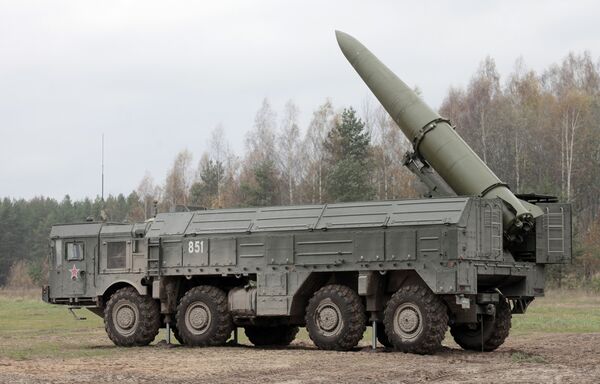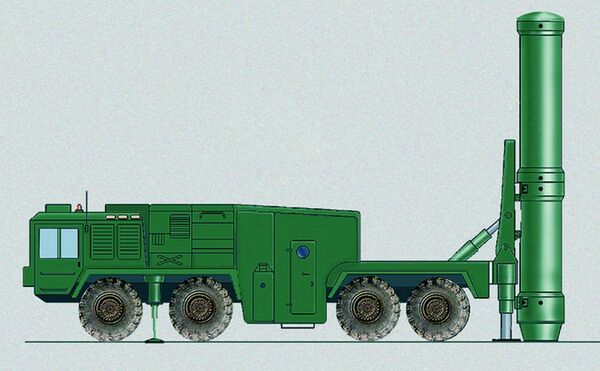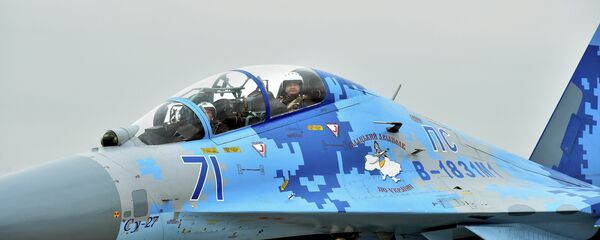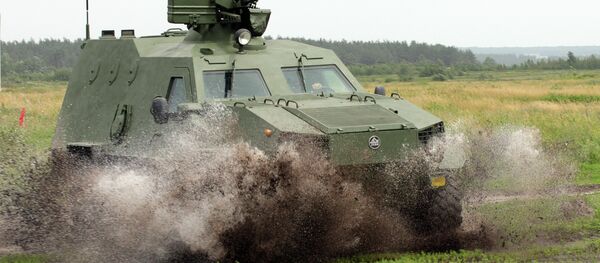Last week, the local media in Ukraine's Dnepropetrovsk region launched a tirade against authorities in Kiev for the latter's supposed attempts to sabotage the creation of a new weapon, the Grom short-range ballistic missile (SRBM) system. If created, it would be a Ukrainian analog to the Russian 9K720 Iskander.
According to Dnepropetrovsk's MOST news agency, Kiev officials are 'twisting the arms' of the Yuzhnoye Design Bureau and the Pavlograd Chemical Plant, two enterprises involved in creating the weapon.
Engineers speaking to the news agency explained that the Grom is being developed using money from a mysterious foreign client. Moreover, the system, presently in its third year of active development, will be prepared for testing as soon as this fall.
Speaking to MOST, Pavlograd Chemical Plant general director Leonid Schiemann explained that after receiving private financing of about one billion hryvnia ($40 million), engineers have created the necessary manufacturing potential, restored laboratories, and engaged in the testing of the system's components. As a result, they were able to create a prototype of the weapon.
According to Sheimann, Grom would allow the army to fight at a distance from the front lines in the civil war in eastern Ukraine, "and to preempt the attack of any aggressor."
However, according to Evgeny Ustimenko, the plant's technical director, the policy of a number of institutions of the government in Kiev not only shows an unwillingness to stimulate the production of modern weapons system, but gives the impression of a purposeful campaign to destroy the country's leading defense enterprises.
The system's designers have asserted that the complex would be able to defeat the most advanced missile defense systems, including the Russian S-300 and S-400 systems. Like the Russian Iskander, Grom's missiles are expected to use unpredictable flight trajectories.

Moreover, according to Svobodnaya Pressa military observer Anton Mardasov, the system's described 300 km range "is no more than a formal legal constraint associated with the Missile Technology Control Regime," a multilateral export control convention to which Ukraine is a partner. Domestically, the journalist noted, Ukraine would not be subject to that agreement's restrictions.
According to Mardasov, questions remain as to whether the Ukrainian military-industrial complex will actually be able to build the new weapon. "The fate of the Borisfen and Sapsan missile systems, hatched earlier by Kiev, is well known. The former was scrapped due to a lack of funding in 2003. The latter was shuttered in 2013, after over 200 million hryvnia (about $24.5 million dollars at the time) was spent on it…"
Still, Mardasov suggested that the situation surrounding the Grom system may yet be different. Firstly, "it is possible that this project will combine all the developments previously reported on by Kiev," resulting in movement "toward the creation of a unified high-precision missile system." Second, the key factor limiting previous developments, including the Sapsan, had been financing. "But if media reports are to be believed, Grom is being financed from abroad. This radically changes the picture."

Accordingly, the journalist suggested that there are two important questions which require answers: "Is it possible that in the near future we will see Ukraine's 19th Missile Brigade, deployed in Khmelnitsky, armed with the Grom system? And who is the project's foreign sponsor?"
For answers to these questions, Svobodnaya Pressa turned to several Russian experts, including Yuri Savelyev, a veteran rocket scientist and the former rector of the Baltic State Technical University.
Savelyev began by recalling that the United States has been actively cooperating with Ukraine in the field of rocketry. For instance, he said, in the 1990s,"Boeing took part in the 'Sea Launch' ocean-based space rocket project, using the [Ukrainian] Zenit-3SL, consisting of the Zenit-2S two-stage launch vehicle developed by Yuzhnoye design bureau, and the DM-SL booster, developed by Russia's Energiya design bureau outside Moscow."
Still, the expert also suggested that he hasn't seen any evidence of US involvement in the Grom project. In fact, he believes that it's the German government that may be looking to use Ukrainian know-how to develop a new SRBM system. "Germany could be the sponsor…The German army is equipped only with the American MLRS M270. With the help of the Yuzhnoye and Yuzhmash design bureaus, the Germans would be able receive designs both for short-range ballistic missile systems, and, in the future, for long-range systems as well," Savelyev noted.
"According to some reports, representatives of Ukraine's Luch design bureau participated in the Sino-Belarusian project on the Polonez MLRS, recently successfully tested by Minsk," Khramchikhin said.

However, Andrei Frolov, the editor-in-chief of Arms Export magazine, said he was very doubtful about Grom's prospects, pointing to a long list of failed projects previously announced by Ukrainian authorities, and Ukrainian designers' habit of putting a new label on old systems.
With regard to the possible foreign sponsors, Frolov suggested that these could be Saudi Arabia or the United Arab Emirates.
"As far back as 2003, representatives from the UAE showed interest in Ukraine for the development and production of cruise missiles for the UAE's air force, and in ballistic missiles. The commander of the country's air and air defense forces even visited Kiev."
Ultimately, the analyst warned that if Ukraine does manage to finish development of the Grom and actually build the system, its primary targets will be the rebellious regions of the Donbass.









